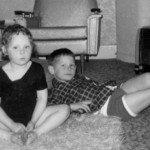Diagnosis of autism before the Triad of Impairments
Leo Kanner (as in Kanner Syndrome aka Classical Autism) was according to Wikipedia:
“the first physician in the world to be identified as a child psychiatrist, founder of the first academic child psychiatry department at Johns Hopkins University Hospital and his first textbook, Child Psychiatry in 1935, was the first English language textbook to focus on the psychiatric problems of children. His seminal 1943 paper, “Autistic Disturbances of Affective Contact”, together with the work of Hans Asperger, forms the basis of the modern study of autism”.
In fact our founder of the diagnosis of autism, Kanner referred to autism as Childhood Psychosis and first began writing about autism in 1943 (and speaking about it since 1938), 4 years before Temple Grandin was born in 1947. Temple, however was not diagnosed as psychotic at age 2. She was diagnosed as brain damaged. This would indicate what today would present as Pervasive Developmental Disorder. Although awareness of autism was extremely poor in 1949 when Temple was diagnosed as brain damaged there may have been a difference in presentation between disturbed or psychotic children and those with brain damage.
To Kanner, autistic children were essentially psychotic. By the 1950s we had ‘progressed’ to being referred to as ‘Feral. Now I know why my mother introduced me as psychotics and my father introduced me as fe…ral! aiaia.
Autism remained referred to and thought of as childhood psychosis until the mid 1980s and Francis Tustin, who followed on from the works of Kanner and then Bettleheim, was still publishing works about autism as a childhood psychosis since 1972 and into 1981.
It was Lorna Wing‘s progressively more cognitive model, the Triad of Impairments in 1976 that began to view autistic children not as psychotic but developmentally disabled, particularly cognitively, and this generally implied ‘mental retardation’. (I met with Lorna Wing in 1991, the year Nobody Nowhere came out. She spent an hour with me interviewing me) but this was still brought out in an era where autistic children were still generally thought to be psychotic and emotionally disturbed.
It was from 1991 when Uta Frith, a colleague of Lorna Wing translated the works of Hans Asperger into English that autism was finally thought (by 1993-94) to include those capable of normal, even high intelligence.
So without the Triad of Impairments how was a child diagnosed as autistic in the 40s, 50s, 60s, even up to 1974?
They were diagnosed as psychotic children. They were essentially thought to be incomprehensible, withdrawn, mute or incoherent because, in a nutshell, they were mad or at least severely emotionally disturbed.
So how did these psychotic children behave?
They behaved like children with incomprehensible movements, actions, utterances which were incomprehensible (echolalia) or mute (considered withdrawn as part of psychosis). They were children who panicked when handled, picked up or when others sought eye contact. They were children fixated on objects or their own body parts who appeared oblivious to their carers or people in general. They were also distinguished from clingy or teary children (deemed at the time to be symbiotic as opposed to autistic).
I was diagnosed as psychotic in 1965 at the age of 2 and a half. The assessment was part of a 3 day hospital stay where deafness was excluded (as was Leukemia – as I also had health disorders). My father said the assessment was based on me appearing deaf, staring through people and having self injurious behaviors (I had tics so was tensing my stomach muscles compulsively, the so compulsively coughing against the force to the point I was coughing blood). I swung between silence and echolalia at this time and was also not toilet trained until age 3. I was very tactile defensive and other than staring through people tended to turn one eye in or use peripheral vision. I don’t know why they didn’t call this brain damage. I was the child of an alcoholic. My father’s mother comes from inbreeding. I was certainly developmentally delayed enough. I was probably assessed as psychotic because I was simply too bizarre to be deemed merely brain damaged. Maybe they thought that brain damaged 2 year olds just don’t act ‘that crazy’.
So that’s how people diagnosed those with autism in the 40s, 50s, 60s and 70s before the Triad of Impairments in 1976. I went on to be labeled emotionally disturbed through primary school in the 70s , diagnosed with language processing disorder around 1972, a teacher then suggested autism when I was ten around 1973, and I was formally diagnosed as autistic in my 20s in 1990. The word autistic was terrifying to mothers until the 1980s. It was a way of saying ‘you caused it’.
I would love to see an online gallery of Temple’s childhood pics from babyhood to adulthood and compare how she presented to how I did to better understand how two people both eventually formally diagnosed with autism originally had such different diagnosis when 2-3 years old. Why did Temple get diagnosed as brain damaged at age 2 and me as psychotic at age 2 and a half? Was it just the different eras? Different countries? Different social classes and how this impacted diagnosis? A complete diagnostic picture would help understand our very different pathways. One thing is for sure they didn’t use the Triad of Impairments or any cognitive model in those days, not until 1976.
My galleries and full diagnostic outline is here.
Donna Williams, BA Hons, Dip Ed.
Author, artist, singer-songwriter, screenwriter.
Autism consultant and public speaker.
http://www.myspace.com/nobodynowherethefilm
http://www.donnawilliams.net
http://www.aspinauts.com


[…] recognised Temple as autistic by a checklist published around that time (Kanner wrote of autism as Childhood Psychosis in […]